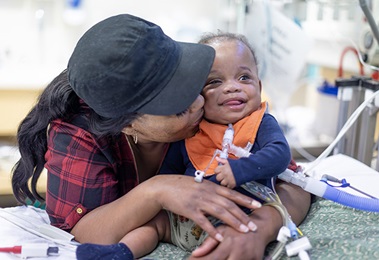Omphalocele
What You Need to Know
- An omphalocele forms during pregnancy and involves the protrusion of abdominal organs through the belly button.
- Omphaloceles can be classified as small or large, depending on the amount of intestine protruding.
- Prenatal ultrasounds usually identify fetuses with an omphalocele in the second or third trimester of pregnancy.
- Omphaloceles are repaired with surgery.
What is omphalocele?
An omphalocele is a congenital (present at birth) condition in which an infant’s intestine or other abdominal organs protrude from the belly button, or navel. A clear, visible layer of membrane tissue covers the organs.
The omphalocele may be classified as small or large.
- Small omphaloceles occur when only a part of the intestine protrudes from the abdomen.
- A large omphalocele occurs when the hole is very large with part of the intestine and the liver protruding from the abdomen. This is also sometimes called a giant omphalocele.
Omphalocele Causes
In most cases, it is not known what causes omphalocele, other than the baby’s abdominal muscles do not properly form early in development.
Approximately 25% to 40% of infants with an omphalocele have other birth defects, which may include genetic problems and heart defects. Infants with giant omphaloceles may also have underdeveloped lungs (pulmonary hypoplasia).
Omphalocele Diagnosis
Prenatal ultrasounds usually identify fetuses with an omphalocele in the second or third trimester of pregnancy. The baby should also have an ultrasound of the heart (fetal echocardiogram) before they are born to identify any heart problems.
After the baby is born, the doctor will carefully assess the omphalocele. The baby may also need imaging studies to look for possible problems with other organs.
Omphalocele Treatment
Omphaloceles are repaired with surgery, although not always immediately. Treatment will depend on the size of the hole and other medical problems identified by testing. It will also depend on how healthy the heart and lungs are in the first few days of life. In some cases, a mechanical ventilator is required to help manage the baby’s breathing during the surgical repair.
Small omphalocele
A small omphalocele is often fixed easily. The baby will need surgery right after birth. During the surgery, the baby’s organs will be put back into the abdomen and the surgeon will close the opening to the abdominal wall.
Large omphalocele
If most of the baby’s abdominal organs are affected, the abdominal organs will not easily fit into the abdominal cavity. Therefore, surgical treatment is performed in stages over weeks to months. Treatment may include the following:
- A protective sheet is put over the baby’s abdominal organs and stitched into place. In other cases, a large patch of sticky tape is placed directly onto the organs, and the tape is changed over time to help bring the abdominal wall together over several weeks. As the baby grows, the organs can more comfortably fit within the abdominal cavity, the patch is removed and the abdominal wall is closed with sutures.
- Sometimes, when the omphalocele is very large or the child has other medical issues, surgical closure cannot be done safely for at least three months. In these cases, an antibiotic ointment is applied twice daily to the defect, and the surrounding skin eventually grows over the omphalocele membrane. The abdominal muscles and skin are then repaired by surgery when the child is much older. In many cases, the final surgery does not occur until the child is between 6 and 12 months of age.
Omphalocele Complications
If the protective membrane around the baby’s organs breaks before surgery, the baby could get an infection.
If an organ is pinched or twisted, it can lose its blood supply, harming the organ.
Living with an Omphalocele
After surgery, the baby may still be at risk for long-term issues. The chance for future problems depends on:
- The size of the omphalocele and whether the liver is involved.
- Other medical problems, particularly those involving the heart, lungs or genetic conditions.
The child’s doctors will make a care plan for the baby to achieve the best possible outlook. This can include careful monitoring of the baby’s nutrition, bowel function and other health functions.





